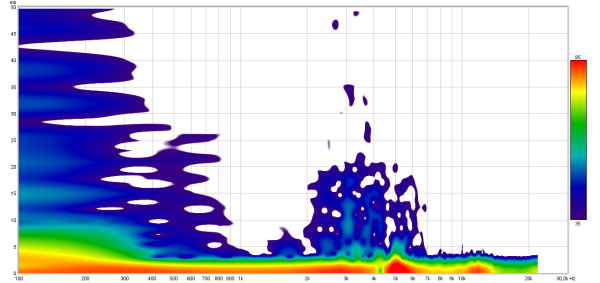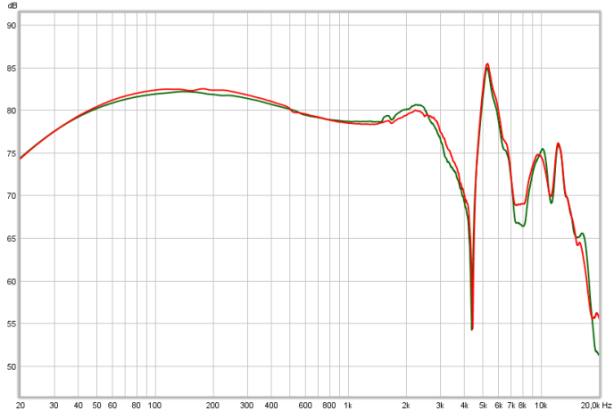PortaPro
back to Koss
back to measurements
home
published: Jan-15-2014, updated Apr-08-2022
NO SMOOTHING is applied to the shown plots. Most measurement sites have some smoothing applied which ‘irons flat’ sharp peaks and ‘wiggles’. I do not use smoothing because some info about sound quality is lost when plots are smoothed.
Aside from a small correction of the microphone itself also some correction in the lowest frequencies is applied to the plots to compensate for the perceived loss of bass when using headphones. This is described HERE in more detail.
A ‘horizontal‘ frequency response curve on the shown frequency response plots on this website thus indicates a perceived ‘flat’ tonal signature.
ALL measurements are made with a good SEAL on a flatbed measurement rig.
The shape of your head, bone structure, pad size, pad ‘softness, (compliance), hair or no hair and or wearing glasses may (drastically) change the frequency response of some headphones, so… your personal experience may differ substantially from these plots.
Frequency response (tonal balance) is the most sound-determining aspect of headphones. A horizontal line shows audible neutral response in the plots on this website. Deviations in different severity at different frequency bands have an effect on the sound character.
The bigger the deviation the stronger the effect.
Below an aid to help determining the sound character of headphones with relation to the frequency response.

Koss PortaPro
The Koss PortaPro is the ‘headband’ version of the KSC35. It is a highly regarded headphone that is very portable, can be folded so it takes up less space when transporting and is very comfortable on the head.
The earpieces do not press on the ears but are simply held right next to the ears so there is little to no clamping force.
The headband can be easily adjusted in height but does not feel very sturdy, yet is durable nonetheless. The pads above the earpieces are the ones that rest on the head. With a finicky and difficult to adjust ‘slider’ you can adjust the pressure on the ears somewhat but the system doesn’t work that well for me (it does not ‘hold’ its position).
Another disadvantage to me are the sharp little steel hook and clamp just under the head rests. It will depend on how big ones ears are, but in my case they ‘touch’ in the upper part of the pinnae which is uncomfortable. I removed those clamp/hook construction in my version by sawing it off (steel so not easy to do). The sound quality is something most will NOT complain about, unless they bought one of the many fakes out there.
specifications:
Type: on ear (supra-aural), open
Usage: home, portable
Driver type: dynamic
Pads: replaceable foam
Collapsible: no
Headphone cup connector: fixed
Cable entry: dual sided.
Cable: 1.2m with gold-plated angled 3.5mm TRS jack.
Outer Pad dimensions: thickness = 3mm, diameter = 50mm
Driver size: 34mm
Nom. power rating: 30 mW (estimated)
Max. voltage: 1.3Vrms (4Vpp)
Max. current: 22mA
Max. S.P.L.: 119 dB
Impedance: 58 Ω (measured)
Efficiency: 105dB @ 1mW
Sensitivity: 117dB @ 1V
Weight: g. 2x 19 gram.
Clamping force: very low, clamps behind the ear.
Accessories: soft carrying pouch.
Subjective sound description:
Low bass is not present but bass itself is present. The mids have a warmth to it and not very dynamic sounding but somewhat muffled. Treble quality is nothing to write home about and not accentuated but a bit coarse and lacking ‘air’.
Overall the sound is easy to adjust to, just like that of the KSC75 and PortaPro and does not have objectionable qualities. Those looking for detailed Hi-Fi sound quality should look elsewhere.
Note: How this headphone sounds (tonal character) is dependent on the fit and seal of the headphone. The description above and measurements below are made with a good seal.
Measurements:
The frequency plot below is from the PortaPro Classic (left, right)  Channel matching s good up to 2kHz. Bass extension is lacking a bit but bass is there. The tonal balance (tilt) is warmish. The frequency curve is smooth up to 3kHz and up to that frequency shows no dips and peaks. This means that instruments and voices have a natural yet warmish tone. The rise near 3kHz gives the headphone good clarity. There is a narrow dip (a null, cannot be EQ’ed) around 4kHz which is also seen in the KPH30i but not in the KSC35 nor in the KSC75.
Channel matching s good up to 2kHz. Bass extension is lacking a bit but bass is there. The tonal balance (tilt) is warmish. The frequency curve is smooth up to 3kHz and up to that frequency shows no dips and peaks. This means that instruments and voices have a natural yet warmish tone. The rise near 3kHz gives the headphone good clarity. There is a narrow dip (a null, cannot be EQ’ed) around 4kHz which is also seen in the KPH30i but not in the KSC35 nor in the KSC75.
The narrow peak at 6kHz may give some sibilance/sharpness in some recordings. The treble and treble extension is a bit subdued.
compared to
Below the PortaPro versus the KPH30i, KSC35, KSC75, (new KSC75) and KSC75x All of these models have very similar DNA but differ in bass extension and response above 2kHz.
All of these models have very similar DNA but differ in bass extension and response above 2kHz.
phase response
Below the phase response of the PortaPro (Left, Right)
Slow phase shifts are not very audible. Sharp changes in a narrow frequency bands may well be audible. The sharp rises at 4.2kHz may well be audible and also responsible for the perceived lesser sound quality of the treble.
Below the CSD (waterfall) plot of the PortaPro (Left and Right are overlaid) The problem area around 5kHz is clearly a resonance. What’s interesting is that the sharp dip seen at 4.2kHz in the frequency response plot is hiding behind the resonance and thus not as deep as the frequency plot suggests. This is also seen in the group delay plot below where the 4.5kHz dip is clearly delayed in time.
The problem area around 5kHz is clearly a resonance. What’s interesting is that the sharp dip seen at 4.2kHz in the frequency response plot is hiding behind the resonance and thus not as deep as the frequency plot suggests. This is also seen in the group delay plot below where the 4.5kHz dip is clearly delayed in time.
Below the Group Delay plot for the PortaPro (Left, Right) Only around 4.2kHz there are some group delay issues but very narrow. The frequency response unevenness is more audible than the delay at 4.5kHz.
Only around 4.2kHz there are some group delay issues but very narrow. The frequency response unevenness is more audible than the delay at 4.5kHz.
A different plot is the spectrum plot. This basically is a CSD (Waterfall) plot but viewed from above where the level differences are colour coded instead of being in the vertical axis. Also the frequency range of the spectrum plot is wider (from 100Hz instead of 500Hz). The time span is also bigger in the spectrum plots and expired time is shown from below to top where in the CSD the time is shown from rear to front.
Below the spectrum plot of the PortaPro (Left channel) Bass is well damped and quickly decays. At around 3kHz there is a resonance but at a low SPL level only and very narrow.
Bass is well damped and quickly decays. At around 3kHz there is a resonance but at a low SPL level only and very narrow.
Step response
Below the step response plot which, when the sound is balanced and well extended should show a fast rise to around 0dB, (indicating fast driver response) and then should be slightly sloping downwards indicating bass extension. (Left, Right)
 Impulse response is correct but bass extension is lacking. The membrane does like to vibrate at 4kHz after an impulse.
Impulse response is correct but bass extension is lacking. The membrane does like to vibrate at 4kHz after an impulse.
modifications
As the pressure on the pads is very light, the ‘coin mod’ doesn’t make much difference for the PortaPro as the foam is not compressed more (as is the case with KSC35/KSC50/KSC75)
Stock pads versus coin modded pads on the PortaPro shows no discernible difference.
The plot is also showing that the foam material itself is acoustically ‘transparent’ and the effect on the other models is due to the pads being compressed more due to the clamping force of the clips on the pinnae.
The coin mod still has the benefit that hairs cannot get stuck in it and touch the driver. Disadvantage is that dust etc. can reach the driver.
(NOTE: the vertical scale is stretched out to see differences more clearly)
steel transport hook poking the top of the pinna
The PortaPro is a very comfortable if the steel ‘hook’ intended for transporting the PortaPro as a small package doesn’t touch the top of your pinnae.
For this reason I removed the steel ‘hook’ which is not easy as the steel is pretty hard material.
Kramer mod
Most people will have heard of the Kramer mod. Part of this mod involves removing the plastic grille in front of the driver and drilling more holes in them. However, also part of the complete mod is replacing the stock foam cushions with thicker ones. The last bit is what actually matters.
On the left a ‘Kramer modded‘ grille, on the right original grille, measurements below. Interestingly enough the effect isn’t as big as many reviews and websites make it out to be.
Interestingly enough the effect isn’t as big as many reviews and websites make it out to be.
(Note: the differences above 8kHz can also come from not positioning the headphone exactly the same way.)
One can read reviews of bass getting increased to much more brighter sounding. A lot of those reports seem to be either based on expectation bias or the thicker pads being used. The latter is what really matters.
Because the measurement rig is NOT built like a real head and the shape of the head as well as the Pinnae has a definite influence on the sound the PortaPro may not be perceived as measured by everyone.
conclusion
The Koss PortaPro is a not too expensive on-ear, or in most cases ‘on temple’ headphone.
Sound quality is quite good/decent. Bass levels depend on seal.
It is easily driven by portable gear. It is open so you can hear sounds around you.
An alternative is the KPH30i but that one is a real on-ear. Also the Sennheiser PX100(II) is an alternative.
The KSC35 and KSC75 have somewhat different drivers and methods to wear them (ear clip).
An excellent alternative for on-ear headphones supplied with some portable gear and for people that don’ like in-ears and earbuds.



